Holographic Keyboards: Typing in Thin Air
In a world where technology constantly pushes boundaries, holographic keyboards are emerging as a futuristic input method that could revolutionize how we interact with our devices. These ethereal interfaces promise to blend the tactile familiarity of physical keyboards with the flexibility and space-saving benefits of virtual interfaces. As we delve into this cutting-edge technology, we'll explore its potential to reshape our digital interactions and the challenges it must overcome to become a mainstream reality.

The Genesis of Holographic Keyboards
The concept of holographic keyboards isn’t entirely new. Science fiction has long tantalized us with images of characters typing on thin air, their fingers dancing across invisible keys. However, the journey from imagination to reality has been a complex one, fraught with technological hurdles and practical limitations.
Early attempts at creating holographic keyboards relied on projecting an image of a keyboard onto a flat surface, using infrared sensors to detect finger movements. While innovative, these systems lacked the true three-dimensional interaction that defines modern holographic technology.
How Holographic Keyboards Work
At their core, holographic keyboards utilize advanced projection technology coupled with sophisticated motion tracking systems. A small projector, typically integrated into a smartphone or tablet, casts a three-dimensional image of a keyboard into the air. This image is created using carefully calibrated lasers and specialized optics that manipulate light to form a coherent, visible structure.
The real magic happens in the interaction. Cameras and infrared sensors work in tandem to track the user’s finger movements with incredible precision. When a user “presses” a holographic key, the system registers the action and translates it into input, just as a physical keyboard would.
The Promise of Typing on Air
The potential advantages of holographic keyboards are numerous and compelling. For one, they offer unparalleled portability. With no physical components beyond the projector and sensors, these keyboards can be integrated into even the smallest devices, potentially eliminating the need for separate keyboard accessories for mobile devices.
Customization is another key benefit. Unlike physical keyboards, holographic versions can be instantly reconfigured to accommodate different languages, layouts, or even specialized functions for specific applications. Imagine switching from a standard QWERTY layout to a video editing console with a simple voice command.
Challenges and Limitations
Despite their potential, holographic keyboards face significant obstacles on their path to widespread adoption. One of the most pressing issues is the lack of tactile feedback. Physical keyboards provide a satisfying click and resistance that many users find essential for accurate typing. Replicating this sensation in mid-air is a formidable challenge that researchers are actively tackling.
Another hurdle is precision. While motion tracking technology has come a long way, ensuring consistent accuracy across various lighting conditions and user behaviors remains difficult. False inputs and missed keystrokes could significantly hamper the user experience if not addressed.
The Road to Mainstream Adoption
For holographic keyboards to move beyond novelty and into everyday use, several key developments are necessary. First, the technology must become more robust and reliable, capable of functioning flawlessly in diverse environments. This includes improving motion tracking accuracy and developing solutions for tactile feedback.
Energy efficiency is another crucial factor. Current prototypes often require substantial power to project and track inputs, which could limit their practicality in mobile devices. Advances in low-power lasers and efficient sensors will be critical in addressing this challenge.
The Future Landscape of Digital Input
As holographic keyboard technology matures, its potential applications extend far beyond simple text input. We could see holographic interfaces integrated into various aspects of our daily lives, from interactive displays in public spaces to customizable control panels for smart home devices.
The healthcare sector could benefit from holographic interfaces in sterile environments, allowing doctors to access information without touching physical surfaces. In education, holographic keyboards could enable more interactive and engaging learning experiences, particularly in subjects like music or programming.
Pricing and Market Impact
While holographic keyboards are not yet widely available for consumer purchase, early prototypes and similar technologies suggest a potential price range of $200 to $500 for initial consumer models. As with many emerging technologies, these prices are expected to decrease as production scales up and the technology becomes more refined.
The market impact of holographic keyboards could be substantial. If successful, they could disrupt the traditional keyboard market, valued at billions of dollars annually. Moreover, they could spark a new ecosystem of applications and devices designed to leverage this innovative input method.
In conclusion, holographic keyboards represent a fascinating glimpse into the future of human-computer interaction. While challenges remain, the potential benefits of this technology are too significant to ignore. As researchers and companies continue to refine and improve holographic interfaces, we may soon find ourselves typing on air as naturally as we do on physical keys today. The journey from science fiction to reality is well underway, and the future of digital input looks increasingly holographic.





